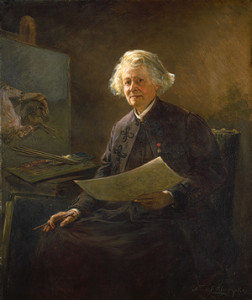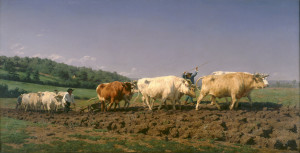Born: March 16, 1822 in Bodeaux, France, died: May 25, 1899 Fontainebleau
Rosa Bonheur, 1898 by Anna Klumpke
Though the subject matter of her paintings might seem commonplace to modern eyes, Bonheur lived an unprecedented and rather unorthodox life. She was born to a fairly wealthy French father, and, as we have seen before, was taught to paint by her father, who studied landscapes. He also doubled as a professional art teacher and was the only local painter who would teach a young Bonheur. The family, which included several other children, was very socially liberal, and probably encouraged Bonheur’s later desire to become such a nonconformist.
The Bonheurs moved to Paris in 1829, where Rosa’s love of art flourished. As a teenager, she started to sketch animals she observed at farms, slaughterhouses, and auctions in order to study their motion and anatomy. She fell in love with these subjects and they became the main focus of her work, which rapidly increased in popularity. But her methods of intensely studying animals proved to be problematic, as places like slaughterhouses tended to be meant for working men. To get around this, Bonheur began dressing like a man to draw less attention to herself. Wearing overalls and pants, which she had to get a special license for (seriously), actually caused Bonheur to become more well-known. Her taste for men’s clothing, which lasted throughout her life, along with her penchant for smoking in public, furthered her eccentric reputation.
Study of a Cow
This piece shows Bonheur’s interests in their simplest form– a lone bull painted in stunning anatomical detail, standing amidst a wide open field
Bonheur first displayed her pieces at a salon in Paris at age 19, where she would enter her works for the next ten years. At a salon in 1847 the artist “was given the ultimate praise, ‘She paints like a man.'” As sad as this sounds, it wasn’t entirely wrong– at that point in time, realism and paintings of nature had been a man’s game. Unsurprisingly, the resilient Bonheur was undisturbed by remarks like these.
The groundbreaking artist’s popularity in France sadly declined near the center of her life, and she received criticism amongst her people for how favored her paintings were in England and America. Her most famous painting, The Horse Fair, was displayed in England in 1855 and “greatly admired” by Queen Victoria. In 1887, Cornelius Vanderbilt bought the painting for an unparalleled price and gave it to the Metropolitan Museum of Art, where it still hangs today.
The Horse Fair, 1852-1855. This magnificent painting is seen as her masterpiece. With it’s rich colors, dynamic composition, and immense size (it’s about 8 by 12 feet!!), I can certainly see why.
In 1865, Rosa Bonheur was the first female to receive the Grand Cross Legion of Honour, an extremely high regard in France. After this, Bonheur’s spent a lot of her life privately, and she shifted from depicting life on the plains to painting pictures of lions at the end of her life. During this time she also live secluded in her chateau with her companion Anna Klumpke, a fellow artist. It isn’t explicitly stated in any of my sources, but it seems like it’s generally assumed that they were romantic partners.
Though she was quite a figure during her time for her habits unusual for a woman, Bonheur really helped to reinvent what it means to be a woman and an artist. She lived her life according to no one but herself in so many ways– in her art, her dress, and her mannerisms. Her disregard for societal norms frequently made people uncomfortable, but allowed her to really transcend the realm of artists. Rosa Bonheur truly left her distinctive mark in both art and feminist history.
Ploughing in the Nivernais, 1849
Royale à la maison
These two paintings represent different periods and interests in the artist’s life. In Ploughing in the Nivernais, the young Bonheur was in the midst of her prolific period of painting realistic farm scenes, while Royale à la maison was painted towards the end of her successful career. Personally, I find the first painting much more compelling. She used much richer and darker colors in her earlier works, and the painting has this intensity that I feel the second work very much lacks.
URLS:
http://nmwa.org/explore/artist-profiles/rosa-bonheur
http://arthistory.about.com/cs/namesbb/p/bonheur.htm
http://www.britannica.com/biography/Rosa-Bonheur
http://www.nytimes.com/1997/10/04/style/04iht-rosa.t.html?pagewanted=all
~Next week I will finally be crossing the pond and introducing you to an American artist, who I’m sure some of you are familiar with. Stay tuned!~





